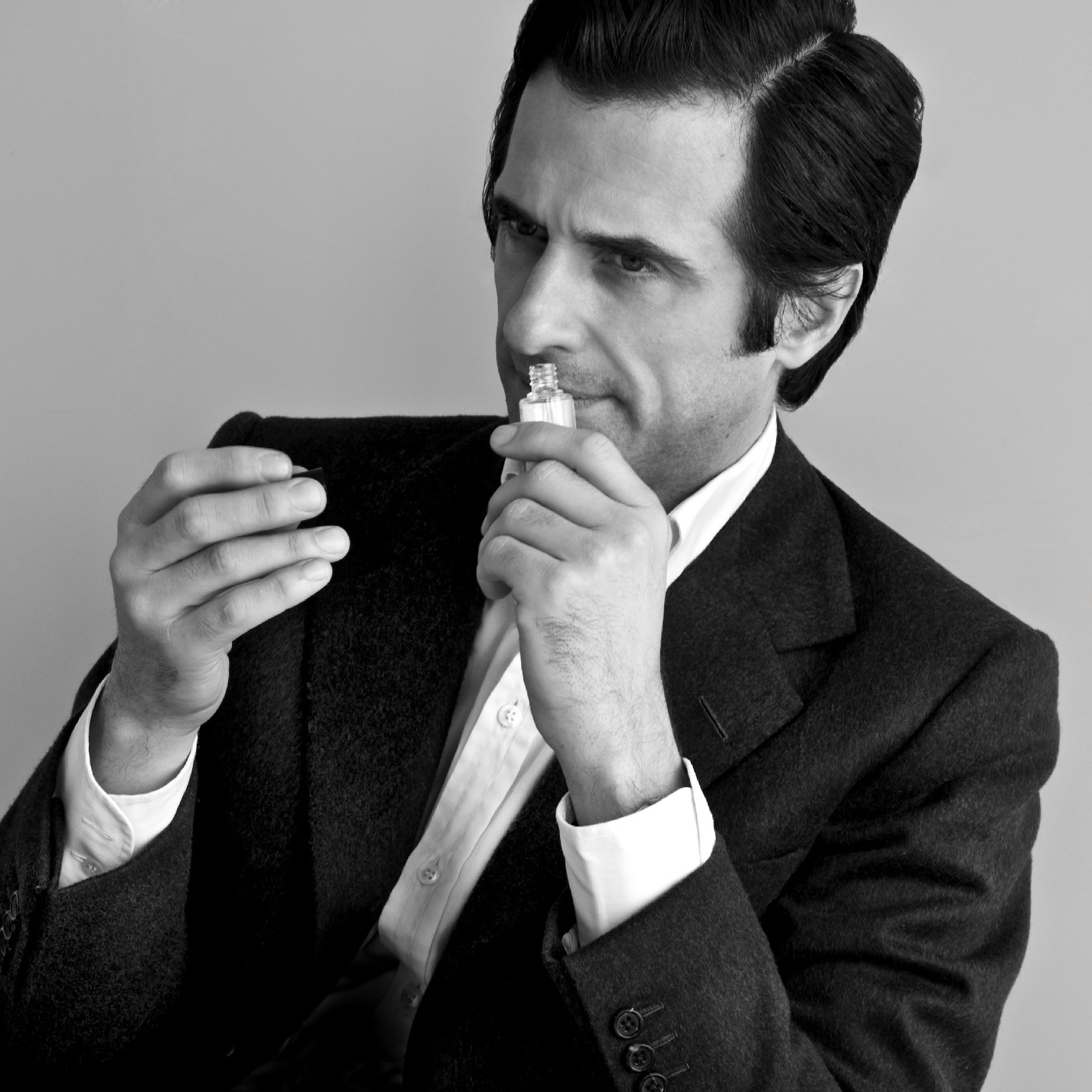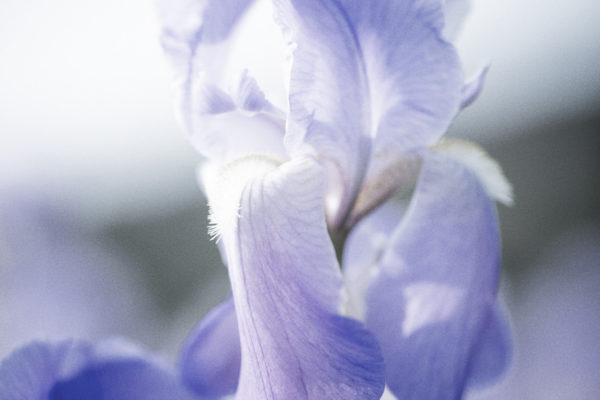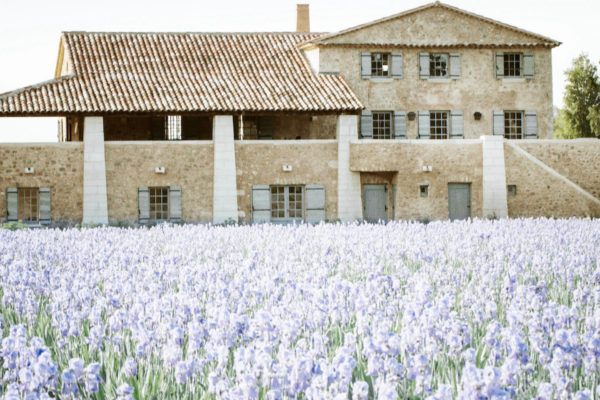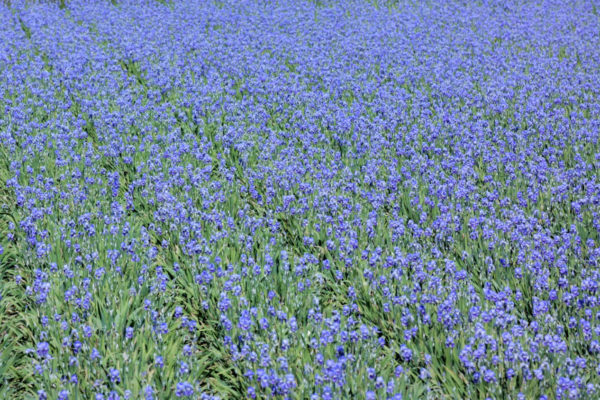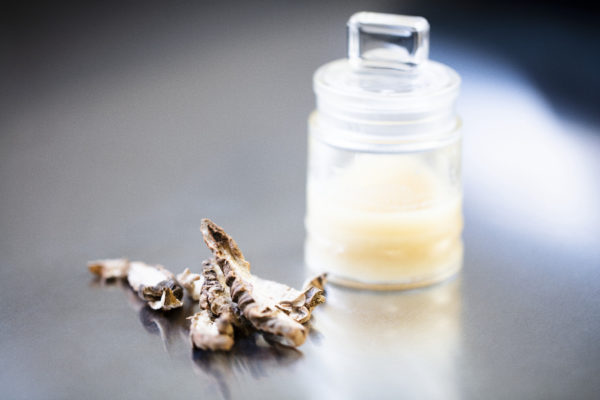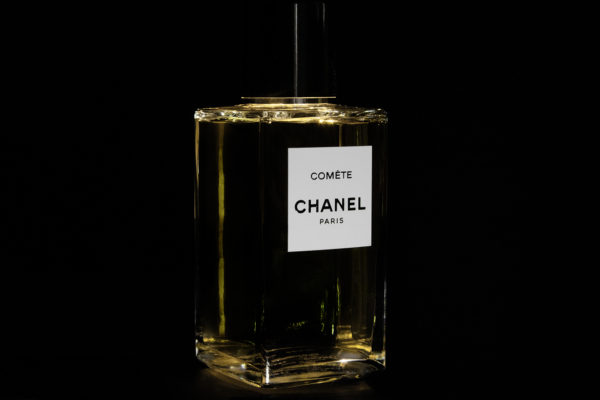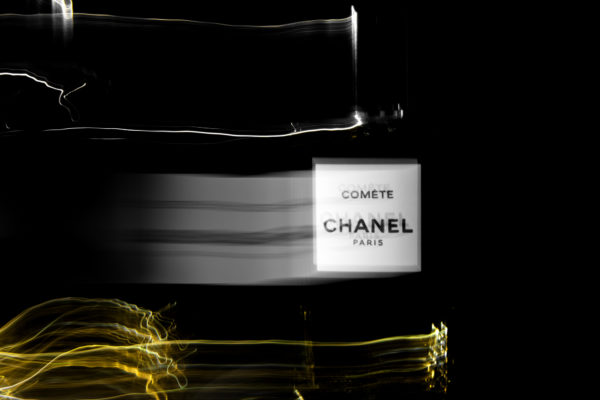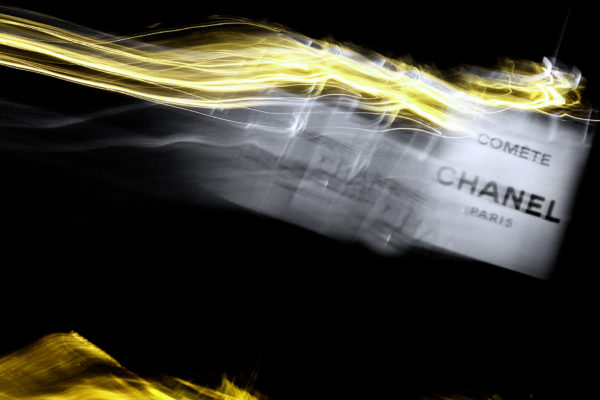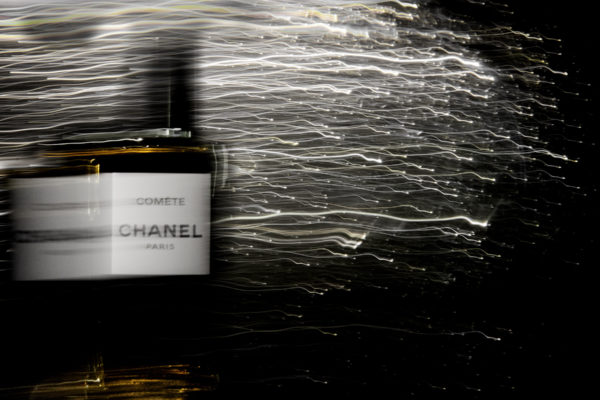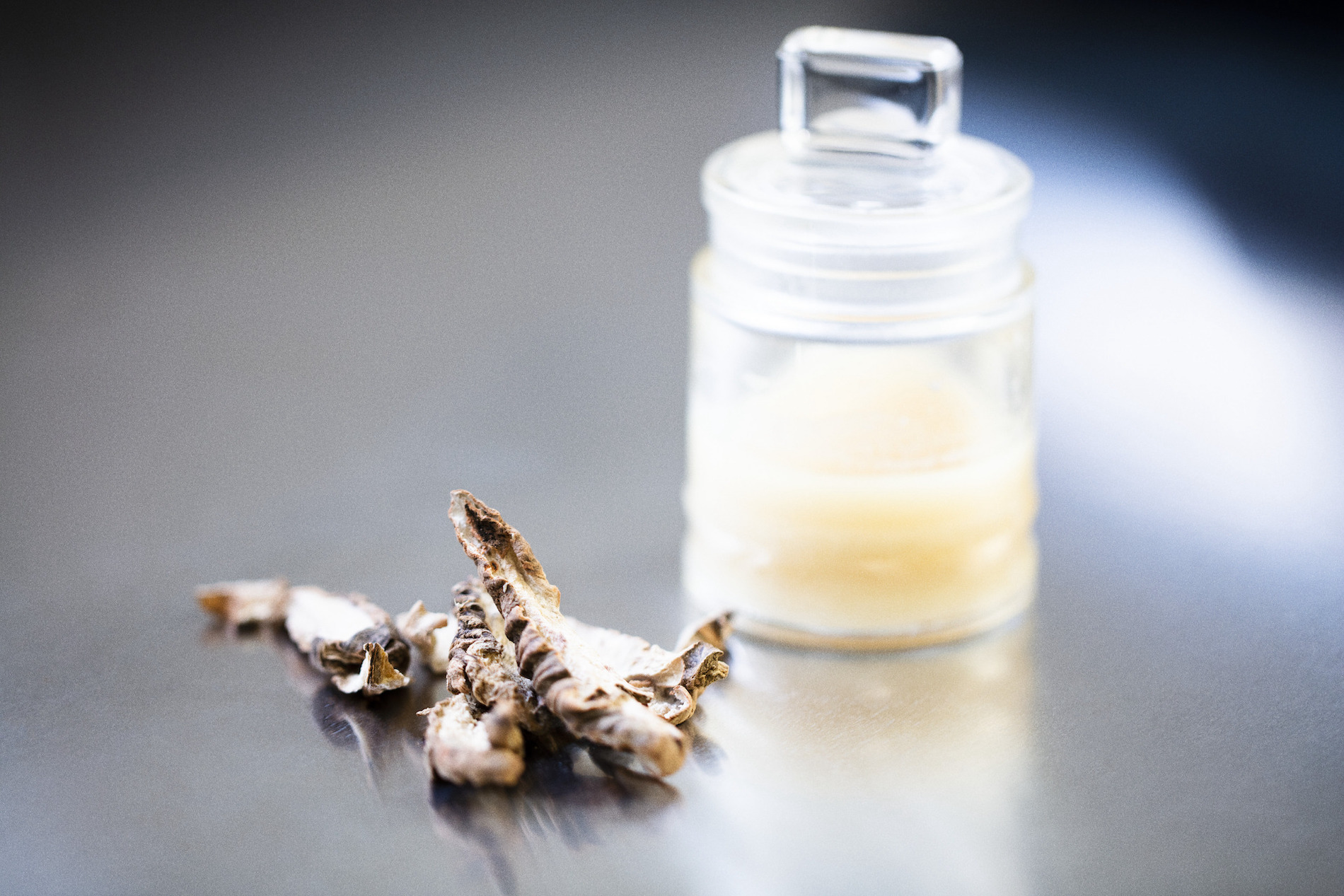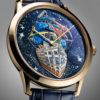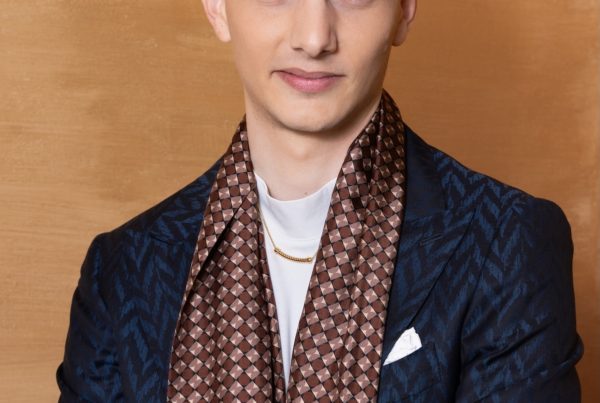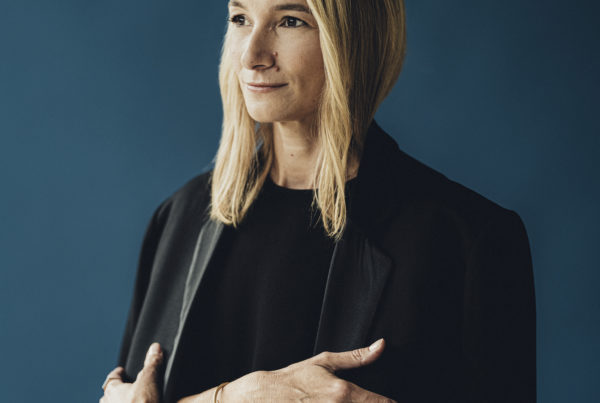The perfume of a stardust
Comète, the new fragrance in Chanel’s Les Exclusifs collection, launched on May 1st, has a complex structure that evokes notes of iris, heliotrope and cherry blossom. An enveloping scent like a veil. The man who knows it best, Olivier Polge, Chanel’s Creative Perfumer, was in Geneva to present his latest opus. Photos of the bottle: Buonomo & Cometti. Interview: Isabelle Cerboneschi
Describing a perfume is a bit like trying to paint a picture of a spirit: it’s a difficult task, because a fragrance is invisible and calls on much more than just the sense of smell. A perfume has the marvellous power to awaken the stories that lie dormant in our imagination. As such, it should be considered an art form.
Comète is a rich and powdery floral « suffused with a fresh and delicate cherry blossom accord. A trace of luminousity and purity transforms into an aura set with heliotrope notes blending into a cloud of iris extract and a musk accord”, as the press release states. It gives a first impression but it doesn’t say anything about the feeling you get when you put it on, as if you’d let yourself be enveloped in an iridescent veil, as light as a dragonfly’s wing. Nor does it say how much this fragrance seems to leave behind a trail of sparkling particles, born of magic, of course. All of this is a product of my imagination. But how do you talk about a perfume without starting from yourself? By talking to its creator.
Olivier Polge was in Geneva in March to present his latest opus. During the meeting, he revealed that his favourite flower was the iris, which he used to great effect in Comète. « It’s not the flower that interests the perfumer, but the root,” explains Olivier Polge. « It’s a complicated raw material because it needs to stay in the ground for three years for the rhizomes to develop. Then we pull them out and dry them so that the olfactory principles can develop after three years of drying. Iris butter requires at least six years of work before it can be used.” The beauty of the iris note is born underground, like a beautiful mystery. “It’s an equivocal scent that’s a little floral, a little woody, a little powdery. It has an abstract side that resonates with Chanel’s perfumery,” continues the perfumer.
The irises used by Olivier Polge to create Comète were grown in Pégomas, near Grasse, where the Mul family also cultivates fields of May roses, jasmines and geraniums, the production of which is reserved for Chanel.
Comète is part of the Les Exclusifs de Chanel collection created in 2007, which includes four historic fragrances created by Ernest Beaux, the creator of the famous N°5: Cuir de Russie (1927), N°22 (1922) Bois des îles (1928) and Gardénia (1925).
When Olivier Polge wanted to sum up the notes in Comète, he mentioned three: heliotrope, iris and cherry blossom. But the construction of this fragrance is much more complex than that, and in the course of our interview, he revealed a little more, just enough to make you want to immerse yourself in this fragrance whose name has a magnificent evocative power and whose notes envelop and reassure.
INTERVIEW
What was the starting point for Comète?
Olivier Polge : Stardust!
The only note in perfumery that can be considered “dusty and luminous” is iris. What path led you to the iris note that is expressed in this fragrance?
It’s a path that’s rarely far from mine. With this idea of stardust and luminosity, I found it interesting not to fall into a form of obviousness, by creating a powdery note with vanilla and almond, which would have been an easy solution. I chose to build it up with flowers – notes of heliotrope, hawthorn, iris – and fruits that are also powdery, like the Morello cherry notes, and to create a kind of white-beige cameo. The iris allowed me to create this luminous, iridescent fragrance, and forms the backbone of the scent.
Since you joined Chanel in 2013, you have created 21 perfumes and evolutions of existing perfumes. There’s a filial link between each of them, as there’s always the same starting point: Gabrielle Chanel, her life, her work. But the challenges are not the same when launching a new fragrance like Gabrielle, an Eau, or an Exclusif. Do you work differently with Les Exclusifs?
Yes, I work on them differently because they make up a collection of fragrances. When I create the next one, I’ll already have 19 others in mind. I’ll have to think about how it’s related and how it’s different. The collection was built by working on certain singularities. When you create a perfume called Coromandel, you weave a thread with the decoration of Gabrielle Chanel’s flat at 31 rue Cambon, where you find her Coromandel folding screens that evoke a certain exoticism. Each Exclusif has a fairly dense style, a particular texture, sometimes even darker tones with leathery notes. That’s why, at a certain point, when I wanted to create a fresher, more fluid, more ethereal fragrance, I had the idea of launching the Eaux collection, the opposite approach. In designing them, I started with eau de Cologne, whose key elements, those that take up the most space in the formula, are citrus fruits, as opposed to the woody, ambery or incense notes often found in Les Exclusifs. The Gabrielle fragrance, on the other hand, had a more universal objective. It had to tell a story about something at the heart of Gabrielle Chanel’s personality, hence the idea of basing its composition on floral notes. We also had to be careful with certain inflections: look for a little more fruity, sparkling notes. With Les Exclusifs, if you abandon yourself to incense, for example, which is more polarising, it will never be a problem.
Listening to what you say, Les Exclusifs are an extraordinary playground!
It’s a very pleasant playground because you create with a lighter frame of mind. There’s very little at stake because the aim is to remain exclusive. And if it only appeals to a certain number of people, it doesn’t matter. This range was created to offer fragrances to people who don’t want to smell like their neighbour.
Comète is your fifth Exclusive?
Yes, and 5 is a lucky number! (Laughs).
How does the creative process work? Do you choose the theme or does it meet the needs of one of Chanel’s lines?
I choose the theme. The starting point is often the name, which will become symbolic and structuring, and I also choose it. As the years go by, certain themes come to me and I come up with a few ideas. With Les Exclusifs, we’re not looking for consensus at all. It’s not a question of having to convince anyone. I’ve been given carte blanche.
You say you have some names in mind: is Aubazine, the orphanage where Gabrielle Chanel grew up, one of them?
Yes, perhaps.
Have you seen the Comète brooch that is kept at the Patrimoine and was it the inspiration for this perfume?
I’ve seen the Comète necklace (whose design is embossed on the box protecting the perfume, editor’s note), but not the brooch. This piece of jewellery inspired me very indirectly. The starting point for an Exclusif is to find something that goes beyond the named thing and to draw subjective threads that make sense for Chanel. The comet was originally a motif that Gabrielle Chanel used in a jewellery collection (“Bijoux de Diamants“, editor’s note) and which eventually became a symbol for Chanel. It expresses her interest in astrology and is very inspiring. What I like is the fact that this motif became one of the elements that Gabrielle Chanel used the most and that it ended up taking up a lot of space in her imagination.
Do the Exclusifs represent all the facets of Chanel?
Yes, in the end, the Chanel style could be the sum of all Les Exclusifs. Each one is a precise work on a very particular element that resonates in almost every profession. What’s striking about Chanel is that there’s a state of mind that runs through everything we create, whether it’s jewellery, perfumes or, of course, fashion.
A perfume is a beautiful paradox: it is both a material and immaterial creation.
Yes, when you pass a perfumed person in the street, their scent is totally immaterial. The perfumer’s work must be totally intuitive. You have to get rid of visual or overly intellectual influences. Creating a perfume calls on an instinctive and sensual sense.
Perfumery is a profession that begins in the earth and evaporates in the most poetic way possible.
You mentioned instinct. When looking at a piece of marble, a sculptor can perceive the Venus that will emerge under his chisels, but what’s in a perfumer’s head to achieve a concrete result while starting from an abstract idea?
That’s what I love about perfume: the confrontation of these two extremes. The starting point for perfume is actually very concrete: when you come to Grasse, you see that before the essence of a flower is captured, there is real agricultural work done on the land. This floral ingredient, infused into the world of Chanel, takes on another dimension and evaporates in a totally immaterial way on the people who wear the perfume. You mentioned the sculptor and his marble, but it’s the same for us perfumers: when we smell a raw material, we know what we can do with it. Often, when we’re presented with new raw materials, we immediately see that it’s a little smell that smells good but doesn’t have the body to be a signature perfume. Faced with a raw ingredient, we know what we can ask of it.
When you describe the fragrance, you mention a note of cherry blossom. How is a cherry blossom reconstituted?
It’s not a reconstitution. The top note of this fragrance is made up of a multitude of little things: a little bit of citrus, a fruity note, an almond note… When I was asked what the three most important notes of this fragrance were, there was something a little floral-fruity in all the little top notes, the almond reminded me of Morello cherry and that gave an impression of cherry blossom. That’s why it’s called a cherry blossom accord, but it’s neither a natural ingredient, nor a reconstitution by Head Space*.
You often say that a fragrance is a language. What did you want to say with Comète?
What I mean when I say that a perfume is a language is that the perfume we wear, beyond words, expresses something we want to say about ourselves, in the same way that the clothes we wear say something about us. Perfume adds another dimension to our story. And this intimacy that we can develop with a fragrance reveals our personality.
When you see a comet…
… It’s rare! Just the other day, when we were presenting Comète at the various markets, I was listening to the news on the radio and I heard that you could see a comet in the sky that only passes by every 70 years. I thought it was extraordinary that this should happen at exactly the same time as the perfume launch! We often associate comets with shooting stars. There’s something magical about them. It makes people fantasise. I’d like people to say that this fragrance is magical, surprising, poetic…
When you see a comet, you have to make a wish. What would be yours?
If I tell you, it won’t come true (laughs).

In the press release, you said that the 1932 Comète necklace, which is worn open next to the skin, evokes the enveloping scent of a skin perfume. What is your definition of a skin fragrance?
There’s something very enveloping about this necklace. If I apply that idea to a fragrance, Comète has to reveal itself on the skin. It’s formulated with a lot of what are commonly called ‘base’ notes, and it’s built on different powdery notes that are a bit similar. It’s as if, once on the skin, this fragrance moves from the second to the third dimension. When you wear it, you have the impression that it infuses and surrounds you.
Can the skin be seen as the final involuntary ingredient in this fragrance?
Yes, I like that idea. I haven’t formulated this fragrance in this way, probably because it would escape me. A perfume is very different depending on the person wearing it. I often think of a perfume as being alive: it has many different facets and the fact of wearing it brings it to life. The skin brings the fragrance to life.
Isn’t a perfumer ultimately an alchemist? He starts with a flower that grows in the earth, extracts it, transforms it into a spirit, then by combining it with other materials he creates an invisible architecture that will reveal certain facets of a personality. Is that how you see yourself?
I really like this notion of alchemy, as if there were connections being created with the person wearing it, some kind of influence. Perfumery is a profession that begins in the earth and evaporates in the most poetic way possible.
* Head Space is a technique designed to recreate the pleasant notes of a flower or fruit that are impossible to obtain using conventional perfumery techniques. The scented object is placed in a container in which a micro-sensor is placed. The scented air around the flower or fruit is absorbed by this micro-sensor. The resulting sample is then analysed by gas chromatography to identify the various molecules.

